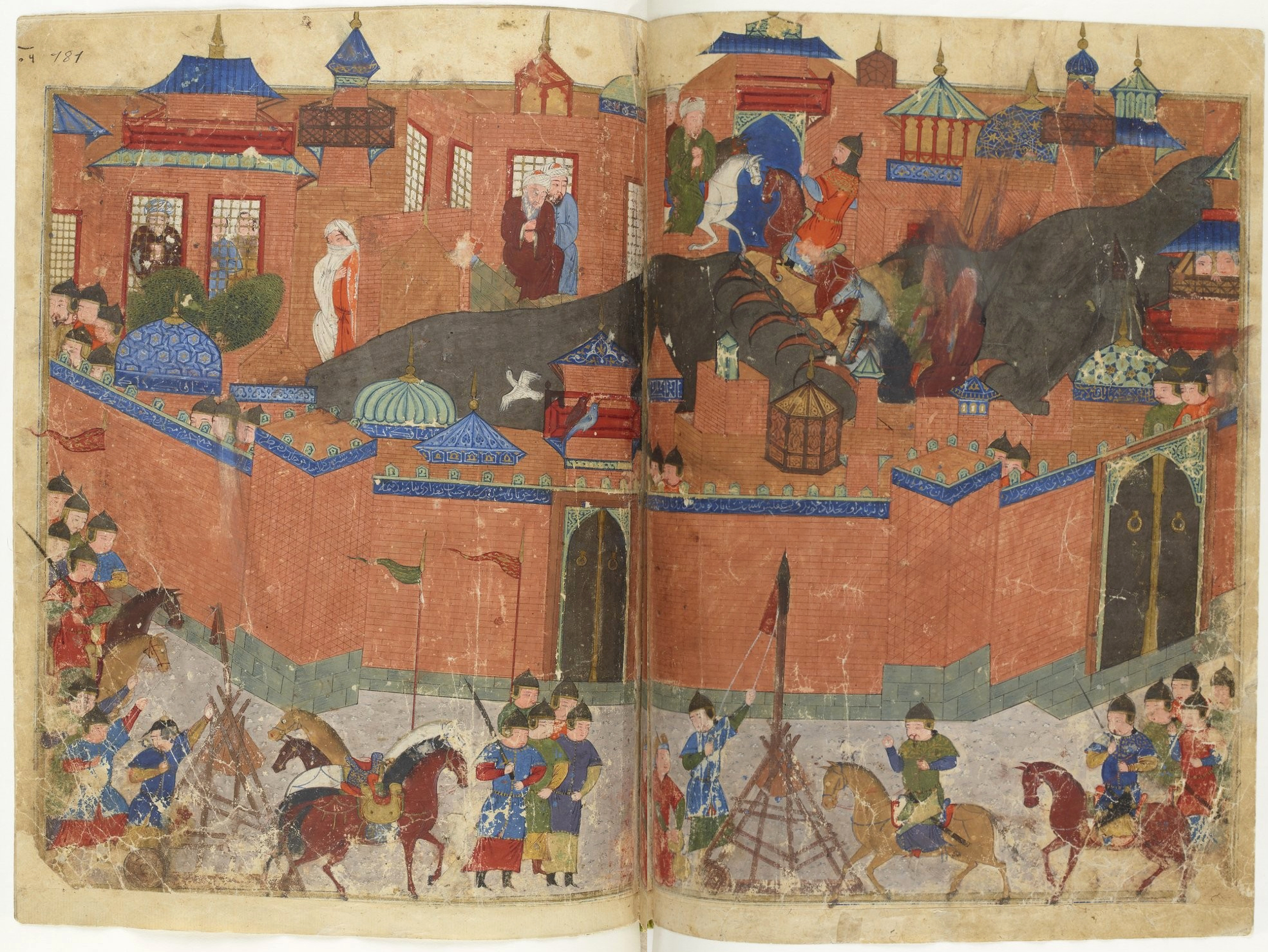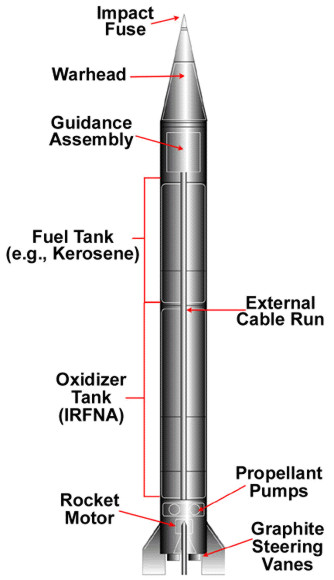|
Al-Abbas (missile)
The al-Abbas missile was an Iraqi Short-range, Surface-to-surface Ballistic missile that was a longer range version of the al-Hussein missile designed to reach most of the Middle East including the Strait of Hormuz. It too was a Scud missile derivative. History The Scud missiles obtained by Iraq during the Iran-Iraq War did not prove helpful as the range of the missiles were only and could not reach the Iranian capital Tehran. The Iraqis would then develop the Al-Hussein missile and later on make the al-Abbas missile which would have an even longer range. In April 1988 the missile was successfully tested, reports suggest that the Iraqis achieved its high range of by increasing fuel capacity, lengthening the size of fuel tanks, cannibalizing oxidizer and propellant tanks from other Scuds and decreasing the regular Scud Payload from . The Iraqis however did not use it later on due to poor missile guidance and flight instability. It is still unknown whether this missile reache ... [...More Info...] [...Related Items...] OR: [Wikipedia] [Google] [Baidu] |
Short-range Ballistic Missile
A short-range ballistic missile (SRBM) is a ballistic missile with a range of about or less. In past and potential regional conflicts, these missiles have been and would be used because of the short distances between some countries and their relative low cost and ease of configuration. In modern terminology, SRBMs are part of the wider grouping of theatre ballistic missiles, which includes any ballistic missile with a range of less than 3,500 km. Models See also * Tactical ballistic missile * Medium-range ballistic missile (MRBM) *Intermediate-range ballistic missile (IRBM) *Intercontinental ballistic missile An intercontinental ballistic missile (ICBM) is a ballistic missile with a range greater than , primarily designed for nuclear weapons delivery (delivering one or more thermonuclear warheads). Conventional, chemical, and biological weapons ... (ICBM) * Anti-ship ballistic missile (ASBM) * Hypersonic cruise missile References Missile types ... [...More Info...] [...Related Items...] OR: [Wikipedia] [Google] [Baidu] |
Tehran
Tehran (; fa, تهران ) is the largest city in Tehran Province and the Capital city, capital of Iran. With a population of around 9 million in the city and around 16 million in the larger metropolitan area of Greater Tehran, Tehran is the List of largest cities of Iran, most populous city in Iran and Western Asia, and has the Largest metropolitan areas of the Middle East, second-largest metropolitan area in the Middle East, after Cairo. It is ranked 24th in the world by metropolitan area population. In the Classical antiquity, Classical era, part of the territory of present-day Tehran was occupied by Ray, Iran, Rhages, a prominent Medes, Median city destroyed in the medieval Muslim conquest of Persia, Arab, Oghuz Turks, Turkic, and Mongol conquest of Khwarezmia, Mongol invasions. Modern Ray is an urban area absorbed into the metropolitan area of Greater Tehran. Tehran was first chosen as the capital of Iran by Agha Mohammad Khan Qajar, Agha Mohammad Khan of the Qajar dyn ... [...More Info...] [...Related Items...] OR: [Wikipedia] [Google] [Baidu] |
Surface-to-surface Missiles Of Iraq
A surface-to-surface missile (SSM) or ground-to-ground missile (GGM) is a missile designed to be launched from the ground or the sea and strike targets on land or at sea. They may be fired from hand-held or vehicle mounted devices, from fixed installations, or from a ship. They are often powered by a rocket engine or sometimes fired by an explosive charge, since the launching platform is typically stationary or moving slowly. They usually have fins and/or wings for lift and stability, although hyper-velocity or short-ranged missiles may use body lift or fly a ballistic trajectory. The V-1 flying bomb was the first operational surface-to-surface missile. Contemporary surface-to-surface missiles are usually guided. An unguided surface-to-surface missile is usually referred to as a rocket (for example, an RPG-7 or M72 LAW is an anti-tank rocket whereas a BGM-71 TOW or AT-2 Swatter is an anti-tank guided missile). Examples of surface-to-surface missile include the MGM-140 ATACMS, th ... [...More Info...] [...Related Items...] OR: [Wikipedia] [Google] [Baidu] |
Ballistic Missiles Of Iraq
Ballistics may refer to: Science * Ballistics, the science that deals with the motion, behavior, and effects of projectiles ** Forensic ballistics, the science of analyzing firearm usage in crimes ** Internal ballistics, the study of the processes accelerating a projectile ** Transition ballistics, the study of the projectile's behavior when it leaves the barrel ** External ballistics, the study of the passage of the projectile through space or the air ** Terminal ballistics, the study of the interaction of a projectile with its target * Ballistic conduction, conduction of electricity with negligible charge scattering * Ballistic movement of muscles in an animal Combat * Ballistic missile, a missile that follows a sub-orbital flightpath * Ballistic knife, a specialized combat knife with a detachable, self-propelled blade * Ballistic shield, a shield meant to protect the user from bullets Arts and media Comics * Ballistic (Image Comics), a comic character of Top Cow Product ... [...More Info...] [...Related Items...] OR: [Wikipedia] [Google] [Baidu] |
Military History Of Iraq
The military history of Iraq, due to a rich archaeological record, is one of the longest in written human history. The region of Iraq, which used to be Mesopotamia, has been referred to as the "cradle of civilization", and wars of conquest have been recorded in this region as far back as the third millennium BC. Because of its geopolitical dominance and ideology based in world domination, the Neo-Assyrian Empire is by many researchers regarded to have been the first world empire in history. The area possesses strategic value, initially for the rich, fertile agricultural region in the Mesopotamian plain, and more recently for large petroleum deposits and access to the oil-rich Persian Gulf. The present territory of Iraq lacks significant strategic barriers, making it difficult to defend against foreign invasion. Mesopotamia *In 2525 BC, there was a battle between King Eannatum of Lagash, and Umma. The battle is recorded on the Stele of the Vultures. The king won the battle by ... [...More Info...] [...Related Items...] OR: [Wikipedia] [Google] [Baidu] |
Scud Missiles
A Scud missile is one of a series of tactical ballistic missiles developed by the Soviet Union during the Cold War. It was exported widely to both Second and Third World countries. The term comes from the NATO reporting name attached to the missile by Western intelligence agencies. The Russian names for the missile are the R-11 (the first version), and the R-17 (later R-300) Elbrus (later developments). The name Scud has been widely used to refer to these missiles and the wide variety of derivative variants developed in other countries based on the Soviet design. Scud missiles have been used in combat since the 1970s, mostly in wars in the Middle East. They became familiar to the Western public during the 1991 Persian Gulf War, when Iraq fired dozens at Israel and Saudi Arabia. In Russian service it is being replaced by the 9K720 Iskander. Development The first use of the term ''Scud'' was in the NATO name SS-1b Scud-A, applied to the R-11 Zemlya ballistic missile. The earl ... [...More Info...] [...Related Items...] OR: [Wikipedia] [Google] [Baidu] |
Al-Samoud 2
Al-Samoud (الصمود, alternately ''Al-Samed'', which means steadfastness in Arabic)Miller, David: ''Conflict Iraq: Weapons and tactics of US and Iraqi Forces.'' Zenith imprint, 2003, page 22. was a liquid-propellant rocket tactical ballistic missile developed by Iraq in the years between the Gulf War and the 2003 Invasion of Iraq. The Iraqi army also developed a solid-fuel rocket version known as Ababil-100. Development The missile was essentially a scaled-down Scud, though parts were mostly derived from the Soviet S-75 Dvina surface-to-air missile. The first test-firing was carried out as early as 1997 and was supervised by UNSCOM. The production started in 2001, and the goal was the assembly of ten missiles each month. The Al Samoud 2 was not fully operational by 2003, but some of them had been already delivered to the Iraqi army. Engine The rocket engine evolved from the S-75 Dvina design and the thrust vector controls from the Scud. The system also included an Iraq ... [...More Info...] [...Related Items...] OR: [Wikipedia] [Google] [Baidu] |
Al-Hussein (missile)
al-Husayn () were a short-range ballistic missile developed in Ba'athist Iraq. An upgraded version of Scud missile, the al-Husayn was widely used by the Iraqi Army during the Iran–Iraq War (1980–1988) and the Persian Gulf War (1990–1991). Development The origins of the al-Husayn could be traced back to the first stages of the war with Iran. Iraq was the first belligerent to use long range artillery rockets during the Iran–Iraq War, firing limited numbers of FROG-7s at the towns of Dezful and Ahvaz. Iran responded with Scud-Bs obtained from Libya. These missiles can hit a target 185 miles away, therefore key Iraqi cities like Sulaymaniya, Kirkuk, and Baghdad itself came within the range of this weapon. Iraq, which also deployed the Scud-B, was conversely unable to strike the main Iranian industrial centers, including the capital, Tehran, because these are located more than 300 miles from the border. To surmount the Iranian advantage, Iraqi engineers designed a program t ... [...More Info...] [...Related Items...] OR: [Wikipedia] [Google] [Baidu] |
Atmospheric Entry
Atmospheric entry is the movement of an object from outer space into and through the gases of an atmosphere of a planet, dwarf planet, or natural satellite. There are two main types of atmospheric entry: ''uncontrolled entry'', such as the entry of astronomical objects, space debris, or bolides; and ''controlled entry'' (or ''reentry'') of a spacecraft capable of being navigated or following a predetermined course. Technologies and procedures allowing the controlled atmospheric ''entry, descent, and landing'' of spacecraft are collectively termed as ''EDL''. Objects entering an atmosphere experience atmospheric drag, which puts mechanical stress on the object, and aerodynamic heating—caused mostly by compression of the air in front of the object, but also by drag. These forces can cause loss of mass ( ablation) or even complete disintegration of smaller objects, and objects with lower compressive strength can explode. Crewed space vehicles must be slowed to subsonic s ... [...More Info...] [...Related Items...] OR: [Wikipedia] [Google] [Baidu] |
Missile Guidance
Missile guidance refers to a variety of methods of guiding a missile or a guided bomb to its intended target. The missile's target accuracy is a critical factor for its effectiveness. Guidance systems improve missile accuracy by improving its Probability of Guidance (Pg). These guidance technologies can generally be divided up into a number of categories, with the broadest categories being "active", "passive", and "preset" guidance. Missiles and guided bombs generally use similar types of guidance system, the difference between the two being that missiles are powered by an onboard engine, whereas guided bombs rely on the speed and height of the launch aircraft for propulsion. History The concept of unmanned guidance originated at least as early as World War I, with the idea of remotely guiding an airplane bomb onto a target, such as the systems developed for the first powered drones by Archibald Low (The Father of Radio Guidance). In World War II, guided missiles were first ... [...More Info...] [...Related Items...] OR: [Wikipedia] [Google] [Baidu] |






.jpg)